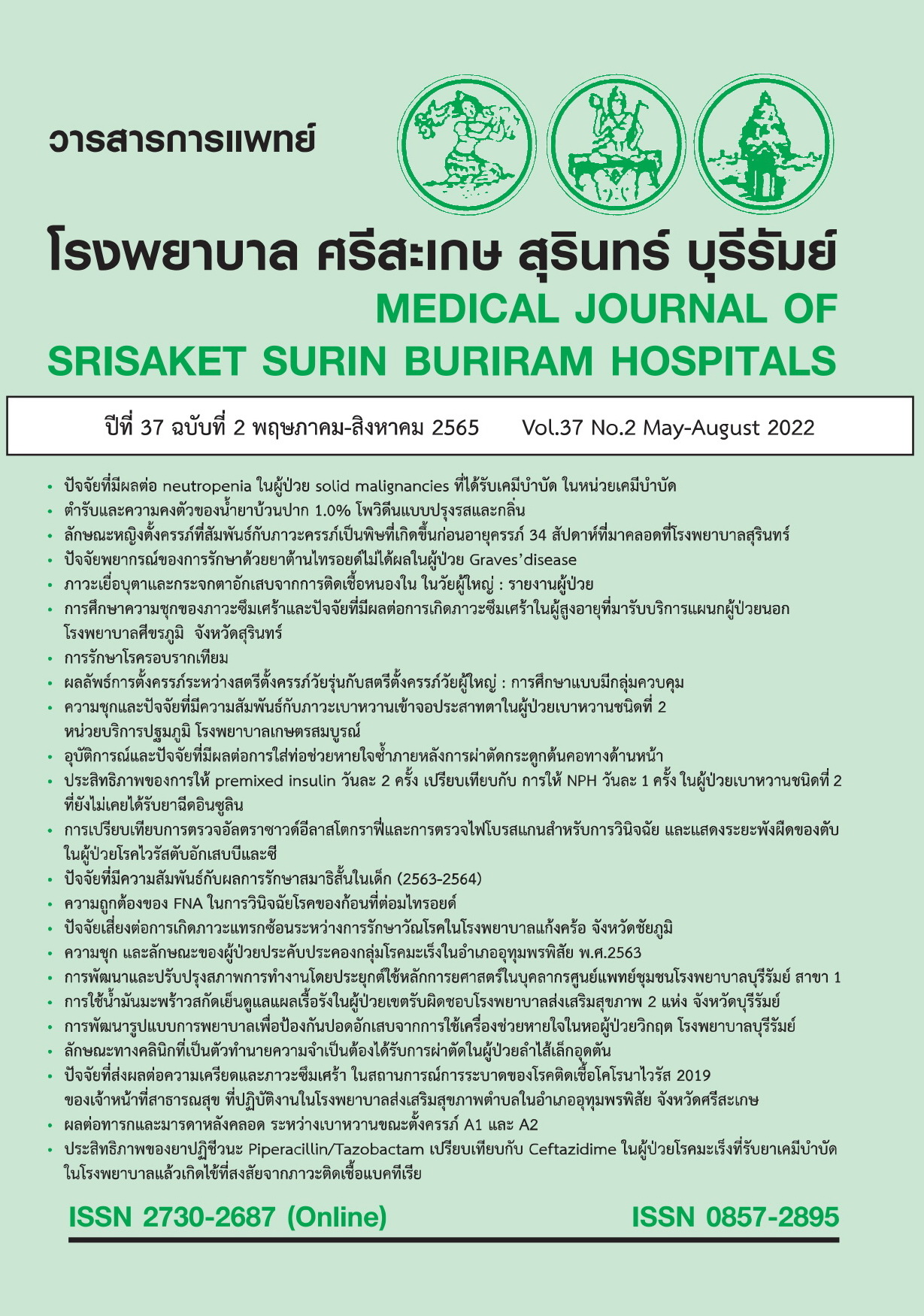ลักษณะทางคลินิกที่เป็นตัวทำนายความจำเป็นต้องได้รับการผ่าตัดในผู้ป่วยลำไส้เล็กอุดตัน
Main Article Content
บทคัดย่อ
หลักการและเหตุผล: ลำไส้เล็กอุดตันเป็นภาวะฉุกเฉินทางศัลยกรรมที่พบบ่อย ผู้ป่วยที่ได้รับการผ่าตัดล่าช้ามีความเสี่ยงต่อภาวะลำไส้ขาดเลือด เกิดภาวะแทรกซ้อนตามมาและมีอัตราการเสียชีวิตเพิ่มขึ้น การตัดสินใจผ่าตัดขึ้นอยู่กับดุลยพินิจของศัลยแพทย์ ยังไม่มีข้อสรุปที่ชัดเจนถึงปัจจัยที่เป็นตัวทำนายความจำเป็นที่ต้องได้รับการผ่าตัดในภาวะนี้
วัตถุประสงค์: เพื่อศึกษาลักษณะทางคลินิกที่อาจเป็นตัวทำนายความจำเป็นต้องได้รับการผ่าตัดในผู้ป่วยลำไส้เล็กอุดตันภายใน 72 ชั่วโมง โดยอาศัยลักษณะทางคลินิกที่สามารถตรวจได้ในสถานการณ์ของโรงพยาบาลทั่วไป
วิธีการศึกษา: การศึกษา prognostic factor research รูปแบบ retrospective cohort design ในผู้ป่วยอายุ 15 ปีขึ้นไป ที่ได้รับการวินิจฉัยว่าเป็นลำไส้เล็กอุดตัน เข้ารับการรักษาในแผนกศัลยกรรม โรงพยาบาลสุรินทร์ ระหว่างเดือนกันยายน 2559 ถึงเดือนกันยายน 2563 ทำการทบทวนเวชระเบียนผู้ป่วยใน แบ่งกลุ่มผู้ป่วยลำไส้เล็กอุดตันเป็นกลุ่มที่ต้องผ่าตัด (operative cases) และกลุ่มที่ไม่ต้องผ่าตัด (conservative treatment) รวบรวมข้อมูลลักษณะทางคลินิก ผลตรวจทางห้องปฏิบัติการ และรังสีวิทยา วิเคราะห์ตัวทำนายที่มีผลต่อการตัดสินใจผ่าตัดด้วยสถิติ multivariable logistic regression
ผลการศึกษา: ผู้ป่วยทั้งหมด 478 ราย ได้รับการผ่าตัด 206 ราย เป็นเพศชายในสัดส่วน 2 ต่อ 1 อายุเฉลี่ย 60 ปี สาเหตุส่วนใหญ่เกิดจากพังผืดร้อยละ 76.2 ปัจจัยที่สามารถทำนายการได้รับผ่าตัดอย่างมีนัยสำคัญทางสถิติ ได้แก่ อาการปวดท้องไม่ดีขึ้นภายใน 24 ชั่วโมง (Odds ratio (OR) 16.7, 95%CI 3.6-78.5, p<0.001) ไม่ถ่ายและไม่ผายลมภายใน 24 ชั่วโมง (OR 7.2, 95%CI 2.1-24.4, p=0.002) และภาพถ่ายรังสีพบ fixed bowel loop (OR 9.2, 95%CI 2.7-31.9, p<0.001) ส่วนปัจจัยทำนายที่มีความสำคัญทางคลินิก คือ peritoneal irritant sign แรกรับ (OR 13.3, 95%CI 0.7-237.6, p=0.078) คำนวณพื้นที่ใต้กราฟ receiver operator characteristic (ROC) จากลักษณะทางคลินิกได้ 0.893
สรุป: ผู้ป่วยลำไส้เล็กอุดตันที่ตรวจพบ peritoneal irritant sign แรกรับ หรือสังเกตอาการภายใน 24 ชั่วโมงแล้ว มีอาการปวดท้องไม่ดีขึ้น ไม่ถ่ายและไม่ผายลม และภาพถ่ายรังสีพบ fixed bowel loop อาจจำเป็นต้องได้รับการผ่าตัดรักษาภายใน 72 ชั่วโมง
Article Details

อนุญาตภายใต้เงื่อนไข Creative Commons Attribution-NonCommercial-NoDerivatives 4.0 International License.
เอกสารอ้างอิง
Catena F, De Simone B, Coccolini F, Di Saverio S, Sartelli M, Ansaloni L. Bowel obstruction: a narrative review for all physicians. World J Emerg Surg 2019;14(20):1-8.
Lee MJ, Sayers AE, Drake TM, Marriott PJ, Anderson ID, Bach SP, et al. National prospective cohort study of the burden of acute small bowel obstruction. BJS Open 2019; 3(3):354-66.
Stewart B, Khanduri P, McCord C, Oheme-Yeboah M, Uranues S, Vega Rivera F, et al. Global disease burden of conditions requiring emergency surgery. Br J Surg 2014;101(1): e9-22.
Fevang BT, Fevang J, Stangeland L, Søreide O, Svanes K, Viste A. Complications and death after surgical treatment of small bowel obstruction a 35-year institutional experience. Ann Surg 2000;231(4):529-37.
Fevang BT, Fevang JM, Søreide O, Svanes K, Viste A. Delay in operative treatment among patients with small bowel obstruction. Scand J Surg 2003;92(2):131-7.
Maung AA, Johnson DC, Piper GL, Barbosa RR, Rowell SE, Bokhari F, et al. Evaluation and management of small-bowel obstruction: an Eastern Association for the Surgery of Trauma practice management guideline. J Trauma Acute Care Surg 2012; 73(5 Suppl 4):S362-9.
Jaffe TA, Martin LC, Thomas J, Adamson AR, DeLong DM, Paulson EK. Small bowel obstruction: coronal reformations from isotropic voxels at 16-section multi-detector row CT. Radiology 2006;238:135-142.
Ten Broek RPG, Krielen P, Di Saverio S, Coccolini F, Biffl WL, Ansaloni L, et al. Bologna guideline for diagnosis and management of adhesive small bowel obstruction (ASBO):2017 update of the evidence-base guidelines from the world society of emergency surgery ASBO working group. World J Emerg Surg 2018;13:24:1-13.
Zielinski MD, Eiken PW, Bannon MP, Heller SF, Lohse CM, Huebner M, et al. Small bowel obstruction-who needs operation? A multivariate prediction model. World J Surg 2010;34(5):910-19.
Zielinski MD, Eiken PW, Bannon MP, Heller SF, Lohse CM, Huebner M, et al. Prospective, observational validation of a multivariate small bowel obstruction model to predict the need of operative intervention. J Am Coll Surg 2011;212(6):1068-76.
Scott JW, Olufajo OA, Brat GA, Rose JA, Zogg CK, Haider AH, et al. Use of national burden to define emergency general surgery. JAMA Surg 2016;151(6):e160480.
Huang X, Fang G, Lin J, Xu K, Shi H, Zhuang L. A prediction model for recognizing strangulated small bowel obstruction. Gastroenterol Res Pract 2018;2018:7164648.
Mu JF, Wang Q, Wang SD, Wang C, Song JX, Jiang J, et al. Clinical factors associated with intestinal strangulating obstruction and recurrence in adhesive small bowel obstruction A retrospective study of 288 cases. Medicine 2018;97(34):e12011.
Bickell NA, Federman AD, Aufses AH. Influence of time on risk of bowel resection in complete small bowel obstruction. J Am Coll Surg 2005;201(6):847-54.
Ceresoli M, Coccolini F, Catena F, Montori G, Di SS, Sartelli M, et al. Water-soluble contrast agent in adhesive small bowel obstruction: a systematic review and meta-analysis of diagnostic and therapeutic value. Am J Surg 2016;211(6):1114-25.
Branco BC, Barmparas G, Schnuriger B, Inaba K, Chan LS, Demetriades D. Systematic review and meta-analysis of the diagnostic and therapeutic role of water-soluble contrast agent in adhesive small bowel obstruction. Br J Surg 2010;97(4):470-8.


